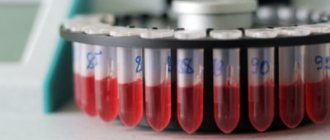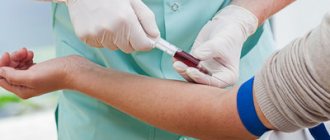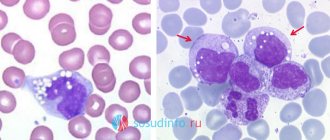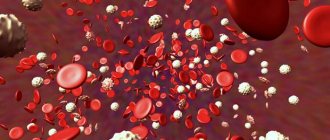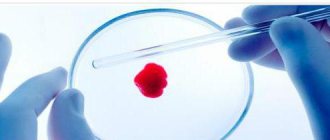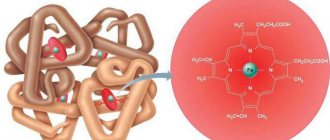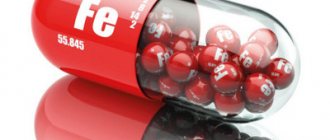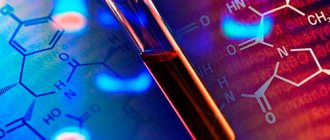Elevated bilirubin in newborns is a fairly pressing problem. Almost half of babies show the first signs of jaundice in the first 7-10 days of life.
The skin and mucous surfaces (sclera of the eyes, surface of the tongue, etc.) may acquire a yellowish tint in the first days of a baby’s life. Such a manifestation is quite normal.
But this does not mean that the listed signs can be left to chance. If you do not pay attention to jaundice in newborns, it can become chronic and cause complications.
Types of pigment in the body
Bilirubin is a greenish-yellow bile pigment. It is formed as a result of the breakdown of outdated fetal blood cells (erythrocytes), which after birth become useless for the baby.
Since the baby's liver is immature, it is not able to cope with the full load and process the entire volume of dead blood cells.
Bilirubin present in the baby’s blood can be of 2 types:
- direct (connected) . It is excreted from the body in feces and urine. This is a water-soluble substance that is formed in the liver and leaves the body without problems;
- indirect (free) . It combines with albumin and enters the liver, after which it is processed by the organ and excreted from the body along with decay products (urine and feces) in the same way as direct. It is insoluble in water. When this enzyme gets inside cells, cellular mechanisms are disrupted, resulting in the toxic effect of free bilirubin on the body.
Experts also use the concept of total bilirubin. This is the sum of intermediate products (bound and free) in the blood serum.
When it comes to monitoring the situation in the first days of a baby’s life, experts pay special attention to indirect (free) bilirubin, which is the cause of the development of the well-known jaundice in newborns.
Physiological (transient) jaundice
This condition rightfully belongs to the so-called borderline conditions of newborns (this group includes conditions that occur normally in most newborns, but require close monitoring, since in the event of an unfavorable development of events, many characteristics of body functions may go beyond normal limits). Transient jaundice occurs in 60-70% of all newborns. By its nature, this type of jaundice is classified as conjugative. This process is based on the restructuring of the hemoglobin system, which takes place after the birth of the baby. The fact is that the fetal hemoglobin differs from that of an adult: during intrauterine development, hemoglobin F (HbF) predominates in the body (it binds oxygen better), compared to the “regular” adult hemoglobin A (HbA), due to which and the transition of oxygen from maternal red blood cells to fetal red blood cells occurs. Soon after the baby is born, his body begins to intensively destroy HbF in order to synthesize HbA. Naturally, the process of hemoglobin breakdown leads to the formation of indirect bilirubin. Since the binding capacity of the liver at this age is low, the concentration of bilirubin in the blood begins to gradually increase. Usually, the first manifestations of physiological jaundice can be observed by the end of the 2nd, and more often on the 3-4th day of life. The intensity of the yellow color may increase slightly until the 5-6th day. As a rule, the process has a benign course, and everything ends well: by the end of the 1st week of life, the activity of liver enzymes increases, the level of bilirubin begins to gradually decrease until it reaches normal, and by the end of the 2nd week the symptoms of jaundice disappear. But if there are “aggravating circumstances” (prematurity, fetal immaturity, previous hypoxia and/or asphyxia, hereditary defects in liver enzyme systems, the use of certain drugs that displace bilirubin from its connection with glucuronic acid - for example, vitamin K, non-steroidal anti-inflammatory drugs, sulfonamides , chloramphenicol, cephalosporins, oxytocin for newborns and mothers), the level of bilirubin in the blood can increase to dangerous levels. In this case, jaundice from a physiological state becomes a threatening condition. Accordingly, a distinction is made between jaundice of prematurity, drug-induced jaundice, jaundice of children with asphyxia, etc.
What is bilirubin? Bilirubin is a substance formed in the body during the breakdown of red blood cells - erythrocytes, or more precisely, the hemoglobin contained in them. Aged and worn-out red blood cells are destroyed mainly in the spleen, resulting in the formation of bilirubin, called indirect or unbound. It is insoluble in water (hence, cannot be excreted by the kidneys) and therefore, for transport in the bloodstream, it binds to albumin, a low-molecular-weight protein in the blood plasma. But the most important thing is that indirect bilirubin is a tissue poison; most of all, it is dangerous for the central nervous system, in particular the brain. Being bound to albumin, it reaches the liver, where its transformation occurs: it binds to a glucuronic acid residue and is converted into direct (bound) bilirubin. In this new state, it is non-toxic to body cells and tissues, is soluble in water, and can be excreted (excreted) by the kidneys. It is also excreted in bile and enters the intestines. In cases where the rate of breakdown of red blood cells exceeds the binding capacity of the liver, indirect bilirubin begins to accumulate in the bloodstream and causes the skin, mucous membranes and sclera of the eyes to turn yellow.
In full-term newborns, the critical level of bilirubin in the blood is 324 µmol/l, in premature infants - 150-250 µmol/l. This difference is due to the fact that premature babies have increased permeability of the blood-brain barrier (a natural chemical-biological barrier between the lumen of blood vessels and brain tissue, due to which many of the substances present in the blood plasma do not penetrate into brain cells), yes and immature brain cells are more sensitive to any kind of adverse effects. Toxic damage to the subcortical nuclei of the brain by indirect bilirubin is called kernicterus, or bilirubin encephalopathy. Its symptoms are severe drowsiness or, on the contrary, a high-pitched cry, convulsions, decreased sucking reflex, and sometimes stiffness (tension) of the neck muscles.
That is why doctors in maternity hospitals carefully monitor the level of bilirubin in the blood of all newborns. When jaundice appears, newborns should be given this test 2-3 times during their stay in the maternity hospital to determine whether there is an increase in the concentration of bilirubin in the blood. The mother may ask whether such tests were taken from the child. For the treatment of hyperbilirubinemia (increased levels of bilirubin in the blood), intravenous transfusions of a 5% glucose solution (it is a precursor of glucuronic acid, which binds bilirubin in the liver), ascorbic acid and phenobarbital (these drugs increase the activity of liver enzymes), choleretic agents ( they accelerate the excretion of bilirubin with bile), adsorbents (agar-agar, cholestyramine) that bind bilirubin in the intestine and prevent its reabsorption. However, today more and more researchers prefer phototherapy as the most physiological and effective method. During phototherapy, the baby's skin is irradiated with special lamps. When exposed to light of a certain wavelength, bilirubin transforms into its photoisomer (it is called lumirubin), which has no toxic properties and is highly soluble in water, due to which it is excreted in urine and bile without prior transformation in the liver. The procedures are usually carried out in the maternity hospital. The indication for phototherapy is the concentration of bilirubin in the blood above 250 µmol/l for full-term newborns and above 85-200 µmol/l for premature infants (depending on the weight of the baby).
Transient jaundice occurs in 60-70% of all newborns.
Jaundice in children fed with breast milk (Aries syndrome) also belongs to the conjugation group. Until now, the reason for the development of this condition remains poorly understood. Perhaps maternal estrogens (female sex hormones) present in milk are to blame for this, since they can displace bilirubin from its connection with glucuronic acid. Perhaps the fact is that the sum of all calories received per day during unsteady lactation will be lower than when feeding with formula (it is known that with relative malnutrition, bilirubin can be reabsorbed in the intestine and re-enter the bloodstream). Be that as it may, during the first week of life, children fed with breast milk (including donor milk) are 3 times more likely to develop transient jaundice than their peers who were transferred to artificial nutrition for one reason or another. But you shouldn’t be afraid of these statistics: it has been proven that early breastfeeding and subsequent feeding 8 times a day generally reduce the incidence and degree of hyperbilirubinemia in newborns. The diagnostic criterion for this type of jaundice is a decrease in bilirubin levels by 85 µmol/L or more when breastfeeding is stopped for 48-72 hours. More often, to carry out this test, the child is not transferred to artificial nutrition even for these two or three days; it is enough to offer him expressed milk, preheated to a temperature of 55-60 ° C and cooled to body temperature - 36-37 ° C. With this treatment, the biological activity of estrogens and other substances in mother's milk, which can compete for liver enzymes, is significantly reduced. This test is sometimes used to exclude other possible causes of jaundice. The course of this condition is benign; no cases of bilirubin encephalopathy associated with Aries syndrome have been described, so treatment is usually not required, and children can be breastfed. Hemolytic jaundice occurs when there is increased hemolysis (breakdown of red blood cells). It may be one of the manifestations of hemolytic disease of newborns (HDN), which develops in Rh-positive children with Rh-negative mother's blood. In such cases, the mother's body can produce antibodies against the fetal red blood cells, which destroy them. The clinical picture of hemolytic disease includes anemia (decrease in the level of hemoglobin and red blood cells), hyperbilirubinemia, enlargement of the liver and spleen, in severe cases - swelling of tissues, accumulation of fluid in body cavities, a sharp decrease in muscle tone, suppression of reflexes. Jaundice most often appears immediately after birth or on the first day of life; bilirubin levels quickly increase to alarming levels. Surgical methods are most often used to treat tension-type headache. These primarily include exchange blood transfusion (RBT), and sometimes hemosorption is also used. In case of PCD, blood containing an increased level of bilirubin and a reduced number of formed elements (cells) of blood is taken from the newborn, and the blood of a donor is transfused. In one procedure, up to 70% of the blood volume is replaced. Thus, it is possible to reduce the concentration of bilirubin and prevent brain damage, as well as restore the required number of red blood cells that carry oxygen. The procedure is often required to be repeated if the bilirubin level again begins to reach critical levels. Hemosorption is the purification of blood from bilirubin, maternal antibodies and some other substances by precipitating them in a special installation. In mild cases of HDN, treatment methods used for transient jaundice can be used.
Advertising
In addition, hemolytic jaundice can develop with hereditary diseases accompanied by defects in the structure of membranes, or erythrocyte enzymes, or hemoglobin molecules. Any of these reasons leads to increased destruction of red blood cells and, as a result, to an increase in bilirubin levels. Jaundice is noted from the first days of life. Associated symptoms are anemia and enlarged spleen. The diagnosis is made by a combination of symptoms and a general blood test, sometimes additional studies are required.
https://youtu.be/sTtqXgodjcc
What level of bilirubin in the blood of a newborn is considered normal?
The norm and limit of bilirubin in newborns are generally accepted norms.
By comparing the data obtained after blood sampling with the normal value, doctors can make an objective conclusion about the child’s health status and take appropriate measures to normalize the indicators. The norm for babies born at term is 256 µmol/l . If the baby was born prematurely, a figure of 171 µmol/l is considered normal.
At the same time, the skin, sclera of the eyes and mucous membranes may still have a yellowish tint, without posing a danger to the life and health of the baby. As a rule, such pigmentation goes away on its own within 7 to 10 days after the baby is born.
The critical indicator for children born at term is considered to be 324 µmol/l, and for premature babies – 150-250 µmol/l. With such results, specialists usually insist on drug treatment. And their fears and demands are completely justified. Lack of treatment can provoke the development of serious complications or chronic pathologies.
Obstructive jaundice
Occurs due to severe disturbances in the outflow of bile, obstruction (blockage) of the bile ducts. This jaundice develops with malformations of the bile ducts (atresias, aplasias), intrahepatic hypoplasia, intrauterine cholelithiasis, compression of the bile ducts by a tumor, bile thickening syndromes, etc. A characteristic sign of this type of jaundice is a yellowish-greenish tint of the skin, enlargement and hardening of the liver , constant or periodic discoloration of stool. Jaundice as a clinical symptom appears at 2-3 weeks of life. For diagnosis, X-ray methods and biopsy are used (examination of a piece of tissue under a microscope, as well as using various biochemical methods). Treatment is most often surgical.
In this article, we tried to talk about some of the most common causes of jaundice in newborns. We hope it will allow you to avoid unnecessary worries, and in cases where your fears are not unfounded, you will quickly find your bearings and show your baby to a specialist in time.
Dorofey Apaeva, pediatrician, Scientific Center for Children's Health of the Russian Academy of Medical Sciences, Moscow
Table of norms by day
Over time, the amount of fetal hemoglobin in the body decreases. The liver gradually processes dead blood cells, as a result of which the skin and mucous membranes acquire a normal shade, and the condition of the baby is normalized.
You can get complete information about acceptable indicators by looking at the table data.
Table of bilirubin norms in newborns by day:
| Baby's age | Bilirubin, µmol/l |
| 12-24 hours | up to 85 |
| 36 hours | up to 150 |
| 48 hours | up to 180 |
| 3 – 5 days | up to 225 |
| 6 – 7 days | up to 145 |
| 8 – 9 days | up to 110 |
| 10 – 11 days | up to 80 |
| 12 – 13 days | up to 45 |
| from 14 days or more | until 20.5 |
Exceeding the indicators indicated in the table is an alarm bell for specialists. In such cases, immediate medical measures and constant monitoring of the child’s condition are required.
If the indicators are significantly exceeded, urgent hospitalization of the child and individually prescribed drug treatment are required.
How does a blood test for bilirubin work?
If the doctor has prescribed a blood test for bilirubin or a biochemical study, then you must prepare for it. To obtain reliable data, you need to donate blood on an empty stomach. If the person is elderly or weak, you can have a light breakfast, but no less than 4 hours before the test. The day before, it is recommended to avoid fatty, salty and fried foods. Young children can be tested regardless of meals.
Typically, blood is drawn from a vein using a syringe. However, modern medicine does not stand still; a gentle method is gradually being introduced into practice: measuring the degree of skin coloration if the patient exhibits jaundice. Venous blood must be taken from newborns in the maternity hospital. Most often, the fence is taken from the heels or head. Both methods are completely safe for the child.
After the unpleasant blood sampling procedure is left behind, the laboratory assistants move on to the study. The amount of bilirubin is measured using a special reagent called diazoreagent. The level of total bilirubin can be affected by taking medications, for example, aspirin, heparin, choleretic drugs, following a strict diet, pregnancy, and heavy caffeine consumption. You should definitely inform your doctor about the presence of one of these factors.
Medical care for elevated levels
As a rule, for a baby who has been diagnosed with jaundice, routine observation by specialists will be sufficient. Often, symptoms disappear after 1-2 weeks, even without the use of serious drug treatment.
An effective way to reduce bilirubin in the blood is sunbathing.
If the baby was born in spring or summer, the mother can open the hood of the stroller while walking so that the sun's rays fall on the arms, legs and face of the newborn. In winter there are fewer sunny days, so providing your baby with natural sunbathing will not be so easy.
If the parents managed to catch a sunny day, they can take the baby outside and expose his face to the rays of the sun. In both winter and summer, it is necessary to ensure that the sun's rays do not shine into the baby's open eyes. Despite the obvious benefits of the sun, a newborn should not be exposed to direct sunlight for more than 10 minutes.
On summer days, it is not recommended to sunbathe from 11 a.m. to 5 p.m. During this period, the sun is especially harsh and can harm the child’s health.
To eliminate jaundice, phototherapy procedures can also be performed in the maternity hospital . This requires special equipment.
The baby is placed under a blue lamp, the rays of which help convert toxic bilirubin into normal bilirubin and its painless removal from the body. In this case, the child must wear special glasses or a cap over his eyes, since the rays of the lamp are harmful to vision.
After completing the procedure, many babies experience flaky skin or loose stools. In particularly difficult cases, babies may be given IVs and even a blood transfusion.
Total bilirubin
An increase in total bilirubin in children occurs when:
- functional disorders in the chain of bilirubin synthesis;
- hemolytic disease (newborn jaundice);
- viral hepatitis A, B, C, D;
- congestive hepatic processes (difficult or absent outflow of bile and its excretion into the lumen of the duodenum);
- metastasis of tumors located in other organs;
- lack of vitamin B12;
- Dubin-Johnson syndrome (impaired release of direct bilirubin into the bile ducts from the capillaries);
- Crigler-Najjar syndrome (due to the absence or insufficient production of glucuronyltransferase, the process of conjugation of bilirubin and glucuronic acid is disrupted);
- Gilbert's syndrome (impaired mechanism of bilirubin transport inside hepatocytes to the site of conjugation).
dangerous An increase in total bilirubin may indicate the occurrence of cancer in the liver tissue.
Prevention of jaundice development in newborns
An excellent option for preventing jaundice in a baby is breastfeeding. The sooner the mother puts the baby to the breast after birth, the lower the chance for the newborn to develop jaundice.
Feeding on demand is also considered an effective preventive measure. Traditional medicine advises mothers whose children suffer from jaundice to supplement the baby with rosehip decoction, sweet water and other drinks for babies.
Such a judgment is erroneous. None of the listed liquid options can lower the level of bilirubin in the body. It is better to put the baby to the breast more often. In this case, mother's milk is the best preventive and therapeutic agent for normalizing elevated bilirubin levels.
Direct bilirubin
The normal level of direct bilirubin in children is 0-0.68 µmol/l (a quarter of the total). A slight increase indicates hemolytic (suprahepatic) jaundice. A significant increase indicates the possible presence of such pathologies:
- bilirubin in the urine, indicating liver pathologies (hepatitis, cirrhosis, cancer) long before the appearance of jaundice;
- acute or chronic hepatitis;
- cirrhosis of the liver;
- cholecystitis (inflammatory process in the gallbladder) or cholangitis (inflammation in the bile ducts);
- cholestatic syndrome, in which bile components for one reason or another are not removed from the liver tissue;
- abscess;
- neoplasm in liver tissue;
- fatty degeneration – degeneration of hepatocytes into fat cells;
- Dubin-Johnson syndrome;
- Rotor syndrome (dark pigment is not produced in liver cells);
- chronic pancreatitis;
- leptospirosis is an infection initiated by bacteria of the genus Leptospira, affecting capillaries, incl. in the liver;
- poisoning with toadstool;
- taking certain medications.
Video on the topic
About the consequences and treatment of increased bilirubin in the blood of a newborn in the video:
Bilirubin is an important indicator of health for both adults and babies in the first days of life. Therefore, mothers of newborns should under no circumstances refuse to donate their newborn’s blood for a bilirubin test.
At the same time, parents should be prepared for the fact that the rate will increase and not panic about this. Timely measures taken to eliminate the pathology and complete monitoring of the baby’s health status by specialists will allow you to quickly get rid of the disorder, eliminating the development of complications and chronic pathologies.
Parenchymal jaundice
It develops when liver cells are damaged by infectious or toxic agents, which leads to a decrease in their ability to bind bilirubin. In the first place in this series are intrauterine infections: cytomegalovirus (it is the cause of approximately 60% of all cases of prolonged jaundice in infants), toxoplasmosis, listeriosis, rubella, viral hepatitis. As a rule, the idea of an intrauterine infection arises with the development of prolonged jaundice (when its duration exceeds 2-3 weeks in full-term newborns and 4-5 weeks in babies born prematurely), as well as in the presence of other symptoms (enlargement of the liver, spleen and peripheral lymph nodes , anemia (decrease in the level of hemoglobin in the blood), darkening of urine and discoloration of feces, signs of inflammation in a general blood test (increased number of leukocytes, increased ESR), increased levels of liver enzymes in a biochemical blood test. To make a diagnosis, serological reactions are used (detection in the blood antibodies to viruses or bacteria), detection of RNA or DNA of the pathogen using PCR (polymerase chain reaction is a method that allows you to “recreate” DNA or RNA from small fragments that are found in biological fluids or tissues of the body. After this, the resulting RNA or DNA is examined for species (i.e. determine the type of pathogen).
Complications
In most cases, physiological jaundice passes without complications for the child. High concentrations of bilirubin in the blood can have toxic effects on the body. The first thing that will happen is damage to the central nervous system. At low levels, bilirubin is not able to penetrate the blood-brain barrier and cause brain damage. In some cases, increased breakdown of red blood cells occurs, which is accompanied by a massive release of conjugated bilirubin and its accumulation in surrounding tissues.
A similar condition, accompanied by yellowing of the skin, high concentrations of bilirubin and damage to the central nervous system, is called kernicterus. It can occur in certain pathological conditions caused by pathology of the mother, fetus, or incompatibility by blood group and/or Rh factor. Also, a special role is played by congenital diseases in which hemolysis of red blood cells develops. It has been noted that kernicterus occurs in those newborns whose mothers took sulfa drugs during pregnancy.
In the initial stages, the disease manifests itself as general weakness, increased fatigue, and a weakened sucking reflex. Gradually, the level of bilirubin in newborns increases, the brain is damaged, and tone in the extensor muscles begins to predominate. The child straightens his upper and lower limbs, throws his head back and begins to actively scream. Until now, an indicator indicating the presence of kernicterus has not been established. At the moment, doctors focus on clinical manifestations, the presence of a complicated pregnancy and elevated bilirubin concentrations. If on the third day after birth the total bilirubin level exceeds the norm by 1.5 times, then emergency care is necessary.
